My first tweaked VE table
Well, I managed to collect a nice, hour-long log on my way home, and went ahead with my first stab at tweaking the VE table.
The first thing I noticed is that the computer is pulling tons of fuel from the engine in most areas, just to keep the AFR at 14.7:1. It'd otherwise run rich by default. Recall that I've been having problems with the car lean out. The two statements seem at odds with each other, but they're not: When you lay in on the pedal, the computer remembers the most recent fuel trim and sticks with that as its starting point. If your LTFTs are way off, such as in this case, it might use a trim value that causes you to run waaaay lean when at Wide Open Throttle (WOT).
If you take a look at this display, you can see a lot of what I'm having to deal with:
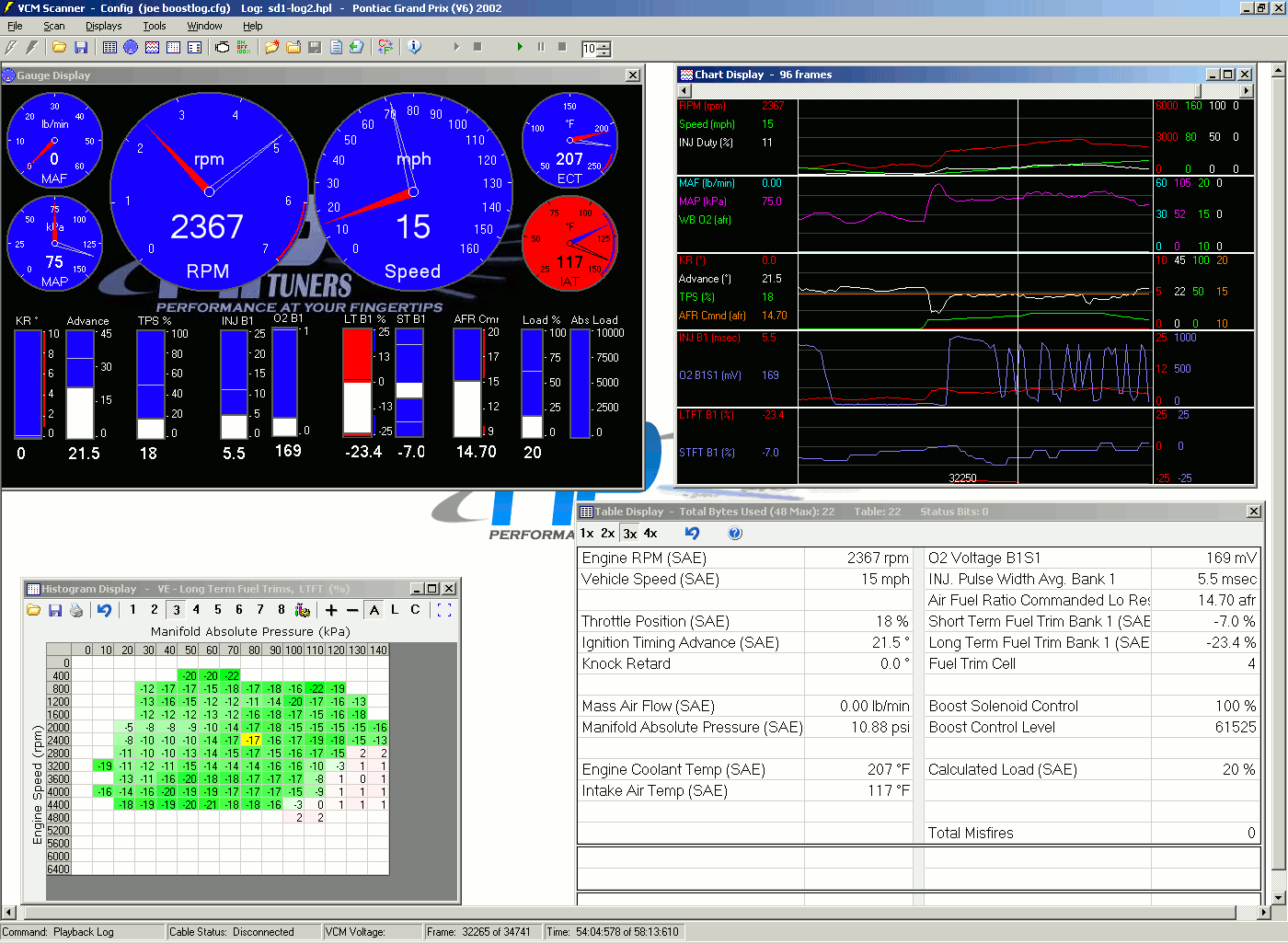
In the lower left is a histogram showing the long-term average fuel trims, indexed by MAP and RPM. This is the same indexing used by the VE table. You'll notice over much of the space, the computer is pulling, on average, 17% of the fuel because its overestimating the cylinder air mass by 17%. But, notice at the lower right of that table, it's actually adding a couple percent. That's a rather sharp inflection there, and is somewhat suspicious. Nonetheless, it hints that going WOT while cruising may indeed be leaning us way out.
If you look at the graph at the upper right, and the corresponding table below it, you can see right at the instant I have highlighted, the computer is actually pulling over 30% of the fuel (-23.4% long-term trim, -7% short term trim). Imagine if I went WOT with it pulling nearly a third of my fuel, especially if at WOT I actually needed all that gas. Ouch?
So, I set about applying this data to the VE tables. Gary's tuning guide recommends a simple procedure, that I will restate even more simplified: Take the average LTFT in each bin of the histogram, and apply that delta to the corresponding bin in the VE table. Once you've done that, smooth the table once, write it to the computer, and repeat the data gathering. I decided to be a little fancier about it, since I knew I hadn't hit as much of the operating range as I would have liked to.
Here's how I modified the procedure:
This gave me a pretty good first stab at a modified VE table. But, if you look at the histogram in the picture above, you'll see I have no data for high RPMs. This caused me to have something of a ridge in the resulting VE table at moderate to low pressure, but high RPM. So, I used some of the tuner software's smoothing functions to further smooth the 4800-6400RPM rows for 30kPa through 90kPa. I didn't smooth the higher kPa areas, since it appears the computer actually does want to richen up that area. The ridge became a pedestal at that point--somewhat more reasonable, I guess.
The final step was to clean up a few other noisy bits around the edges of the graph until I had a reasonably smooth looking VE table. On to the results.
Original VE Table:
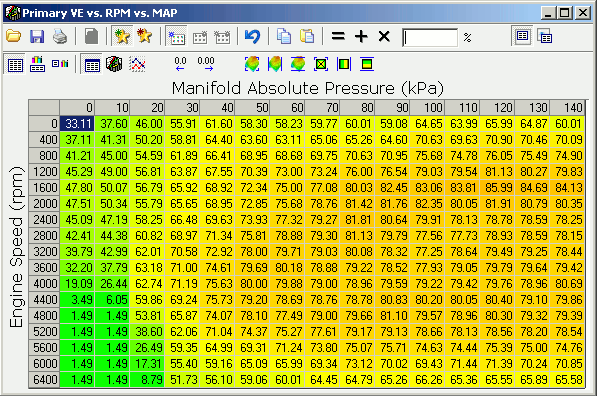
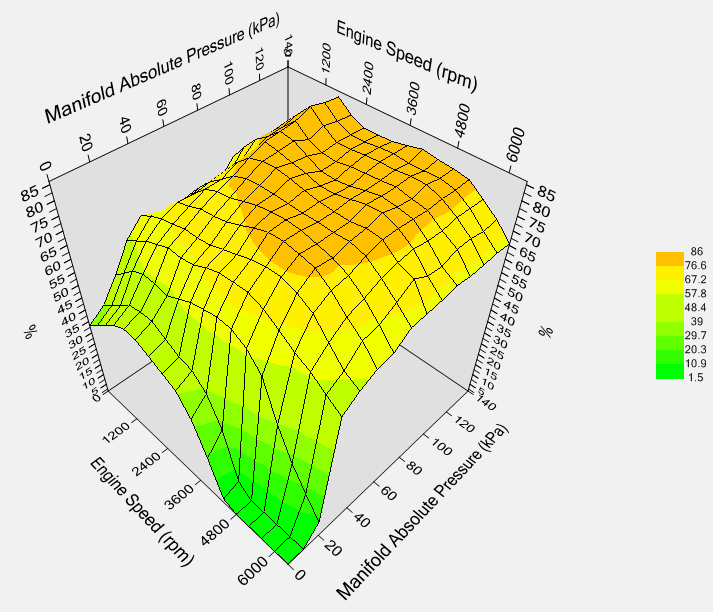
Modified VE Table:
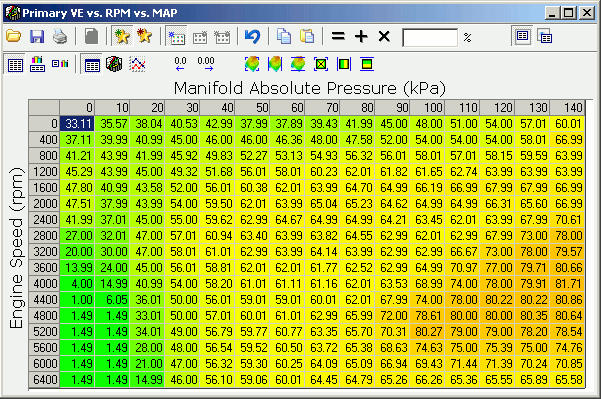
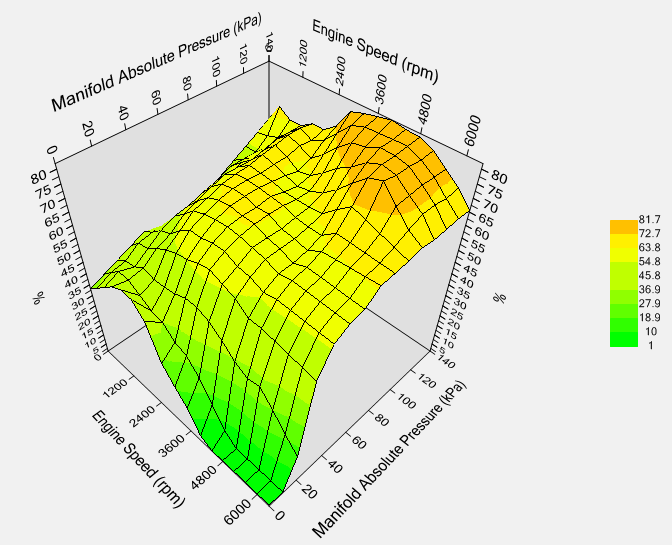


Tomorrow, I'll load the modified table into the car and see how she does on the drive to work. Once I get this table sorted out, I'll then plug the MAF back in and calibrate it.
The first thing I noticed is that the computer is pulling tons of fuel from the engine in most areas, just to keep the AFR at 14.7:1. It'd otherwise run rich by default. Recall that I've been having problems with the car lean out. The two statements seem at odds with each other, but they're not: When you lay in on the pedal, the computer remembers the most recent fuel trim and sticks with that as its starting point. If your LTFTs are way off, such as in this case, it might use a trim value that causes you to run waaaay lean when at Wide Open Throttle (WOT).
If you take a look at this display, you can see a lot of what I'm having to deal with:

In the lower left is a histogram showing the long-term average fuel trims, indexed by MAP and RPM. This is the same indexing used by the VE table. You'll notice over much of the space, the computer is pulling, on average, 17% of the fuel because its overestimating the cylinder air mass by 17%. But, notice at the lower right of that table, it's actually adding a couple percent. That's a rather sharp inflection there, and is somewhat suspicious. Nonetheless, it hints that going WOT while cruising may indeed be leaning us way out.
If you look at the graph at the upper right, and the corresponding table below it, you can see right at the instant I have highlighted, the computer is actually pulling over 30% of the fuel (-23.4% long-term trim, -7% short term trim). Imagine if I went WOT with it pulling nearly a third of my fuel, especially if at WOT I actually needed all that gas. Ouch?
So, I set about applying this data to the VE tables. Gary's tuning guide recommends a simple procedure, that I will restate even more simplified: Take the average LTFT in each bin of the histogram, and apply that delta to the corresponding bin in the VE table. Once you've done that, smooth the table once, write it to the computer, and repeat the data gathering. I decided to be a little fancier about it, since I knew I hadn't hit as much of the operating range as I would have liked to.
Here's how I modified the procedure:
- First, I noticed in the logs that the computer would go to LTFT=0, STFT=0 when the throttle was at 0 and I was braking. I reasoned that this might skew the results, so I threw out those data frames and recalculated the histogram. (It turns out only around 450 of the approx 36000 data frames were affected, so I doubt this had any real effect.)
- I then applied a weighted smoothing function to each cell in the histogram, creating a new delta map. The weighting function was simple:
- Weight each cell by the # of frames that map to that bin in the histogram.
- For each result cell, sum up the weighted source cell + that cell's 8 neighbors. Weight the source cell by an additional 10x in this sum.
- Divide the resulting sum by the total weight to get the new result value.
The effect of this weighted average was to discount LTFT averages in cells in the histogram that did not have very many data frames to back them up, and instead pull in nearby information that might have more samples behind it.
- Weight each cell by the # of frames that map to that bin in the histogram.
- Apply the smoothed histogram data to the VE table to get the new table.
- Tell the HP tuner software to smooth the result.
This gave me a pretty good first stab at a modified VE table. But, if you look at the histogram in the picture above, you'll see I have no data for high RPMs. This caused me to have something of a ridge in the resulting VE table at moderate to low pressure, but high RPM. So, I used some of the tuner software's smoothing functions to further smooth the 4800-6400RPM rows for 30kPa through 90kPa. I didn't smooth the higher kPa areas, since it appears the computer actually does want to richen up that area. The ridge became a pedestal at that point--somewhat more reasonable, I guess.
The final step was to clean up a few other noisy bits around the edges of the graph until I had a reasonably smooth looking VE table. On to the results.
Original VE Table:


Modified VE Table:




Tomorrow, I'll load the modified table into the car and see how she does on the drive to work. Once I get this table sorted out, I'll then plug the MAF back in and calibrate it.